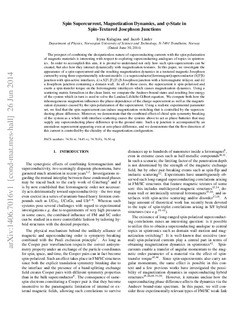| dc.contributor.author | Kulagina, Iryna | |
| dc.contributor.author | Linder, Jacob | |
| dc.date.accessioned | 2017-11-09T08:43:06Z | |
| dc.date.available | 2017-11-09T08:43:06Z | |
| dc.date.created | 2014-09-16T15:39:38Z | |
| dc.date.issued | 2014 | |
| dc.identifier.issn | 1098-0121 | |
| dc.identifier.uri | http://hdl.handle.net/11250/2465098 | |
| dc.description.abstract | The prospect of combining the dissipationless nature of superconducting currents with the spin polarization of magnetic materials is interesting with respect to exploring superconducting analogs of topics in spintronics. In order to accomplish this aim, it is pivotal to understand not only how such spin supercurrents can be created, but also how they interact dynamically with magnetization textures. In this paper, we investigate the appearance of a spin supercurrent and the resulting magnetization dynamics in a textured magnetic Josephson current by using three experimentally relevant models: (i) a superconductor∣ferromagnet∣superconductor (S∣F∣S) junction with spin-active interfaces, (ii) a S∣F1∣F2∣F3∣S Josephson junction with a ferromagnetic trilayer, and (iii) a Josephson junction containing a domain wall. In all of these cases, the supercurrent is spin polarized and exerts a spin-transfer torque on the ferromagnetic interlayers which causes magnetization dynamics. Using a scattering matrix formalism in the clean limit, we compute the Andreev bound states and resulting free energy of the system which in turn is used to solve the Landau-Lifshiftz-Gilbert equation. We compute both how the inhomogeneous magnetism influences the phase dependence of the charge supercurrent and the magnetization dynamics caused by the spin polarization of the supercurrent. Using a realistic experimental parameter set, we find that the spin supercurrent can induce magnetization switching that is controlled by the superconducting phase difference. Moreover, we demonstrate that the combined effect of chiral spin symmetry breaking of the system as a whole with interface scattering causes the systems above to act as phase batteries that may supply any superconducting phase difference φ in the ground state. Such a φ-junction is accompanied by an anomalous supercurrent appearing even at zero phase difference, and we demonstrate that the flow direction of this current is controlled by the chirality of the magnetization configuration. | nb_NO |
| dc.language.iso | eng | nb_NO |
| dc.publisher | American Physical Society | nb_NO |
| dc.title | Spin supercurrent, magnetization dynamics, and φ -state in spin-textured Josephson junctions | nb_NO |
| dc.type | Journal article | nb_NO |
| dc.description.version | submittedVersion | nb_NO |
| dc.source.volume | 90 | nb_NO |
| dc.source.journal | Physical Review B. Condensed Matter and Materials Physics | nb_NO |
| dc.source.issue | 5 | nb_NO |
| dc.identifier.doi | 10.1103/PhysRevB.90.054504 | |
| dc.identifier.cristin | 1155040 | |
| dc.description.localcode | © 2014 American Physical Society. This is the authors' manuscript to the article (preprint). | nb_NO |
| cristin.unitcode | 194,66,20,0 | |
| cristin.unitname | Institutt for fysikk | |
| cristin.ispublished | true | |
| cristin.fulltext | preprint | |
| cristin.qualitycode | 2 | |
